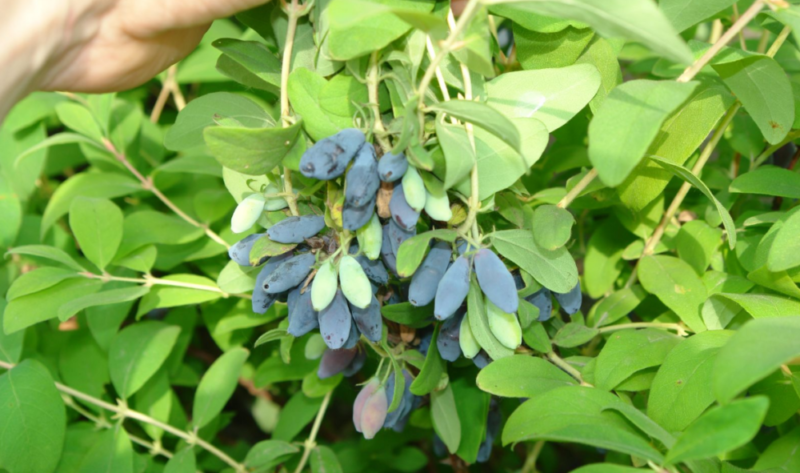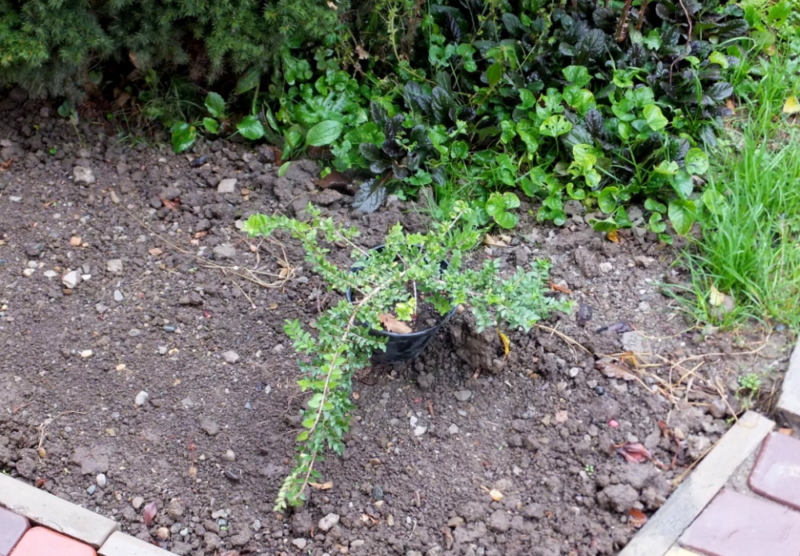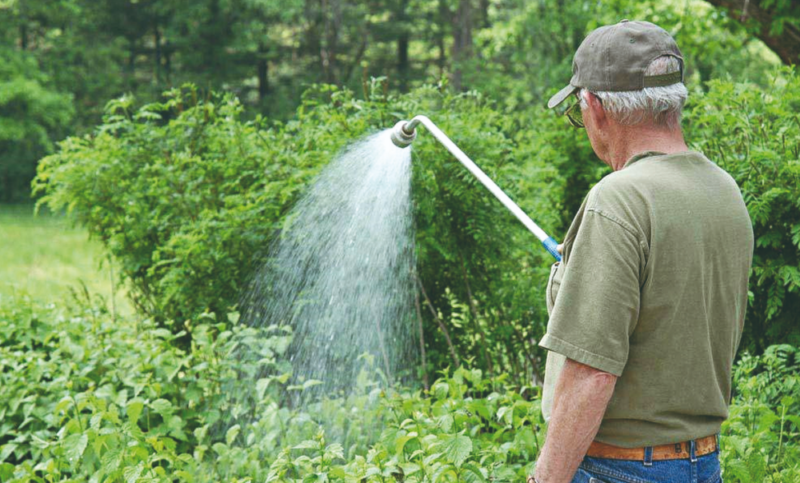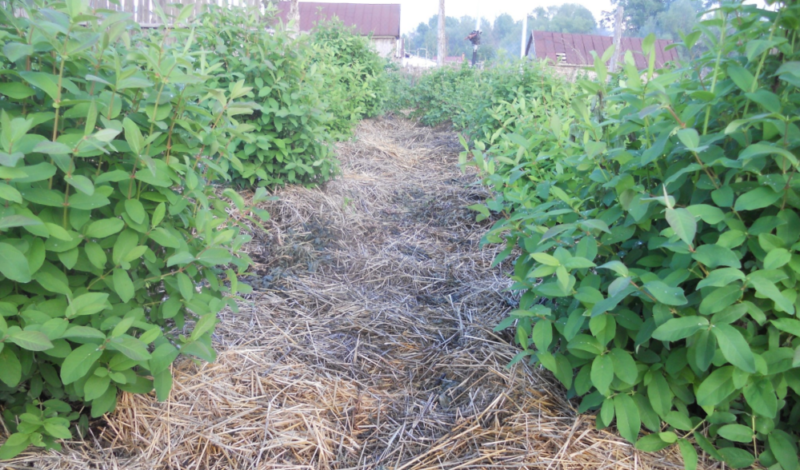Honeysuckle "Delight" is a magnificent hybrid variety with fruits that taste like exotic fruits.
Material Content:
Description of a variety of honeysuckle "Delight"
"Delight" or Kamchatka honeysuckle is the pride of Siberian breeders. If you make a brief description of the variety, then it has a medium-sized bush up to 1.8 meters high. The crown of the bush is sparse, openwork. This form of honeysuckle greatly facilitates the collection of berries.
One berry in length can reach about 5 cm, weigh about 2.5 g. The peel of the fruit is blue-violet, with a waxy, dense coating, the pulp is fragrant and very juicy. The taste is sweet and sour, without bitterness. At the beginning of fruiting, one bush gives up to 2.5 kg of berries, in subsequent years - up to 5.5 kg. Shedding fruit is low.
Berry ripening begins in early June, the yield is very high. The culture is distinguished by winter hardiness, which allows it to be grown even in regions with a harsh climate. The variety is very resistant to fungi and pests.
Outdoor landing
Growing this hybrid will not be difficult even for inexperienced gardeners, so the variety is unpretentious. But in order to collect a rich harvest, one should nevertheless take into account some of the nuances of agricultural technology.
Although the variety is not capricious, it is still better to bear fruit in an open place, closed from the draft and the north wind. It is undesirable that groundwater lay close to the site. The soil prefers slightly acidic or neutral. It is excellent if a plot is selected on which the roots of the plant will be in partial shade, and the crown in the sun.
Honeysuckle planting in the fall is preferable.The dormant period of the plant ends early - already in March, the first leaves begin to bloom on the bushes. The dormant phase begins at the end of July. That is why honeysuckle should be planted in September-October. A step of approximately 150 cm is left between the bushes. An excellent neighborhood for this variety is currant.
Seedlings that have reached the age of three with a well-developed root system are suitable for planting. They should not have any signs of disease.
In advance, in about a couple of weeks, they begin to prepare pits for planting. The depth of the hole should be at least 40 cm. At the bottom, drainage is mandatory. You can use stones, bark or chipped brick.
A seedling is filled up with specially prepared soil mixture of the following components:
- 2 buckets of garden land;
- 1 liter of wood ash;
- 3 tbsp. l superphosphate.
When planting, the pit is shed abundantly at first, and then a small mound is made at its bottom, on which the plant is planted. It is necessary to ensure that the neck of the bush is not buried in the soil by more than 5 cm. The rhizomes are straightened and then covered with prepared soil mixture and shed. The soil must be compacted to remove the "air pockets". Complete the landing by mulching. As the mulching material, coniferous litter or chopped straw is most often used. You can also sprinkle shrub peat.
Plant care
Only if you follow the rules of care, you can collect a generous harvest from the berry. Variety "Delight" loves abundant watering.
Water deficiency will negatively affect the taste of berries and their quantity, will lead to chopping of fruits.
Water the bush throughout the season, but do not allow swamping. It is enough to water the honeysuckle twice a week. Approximate water consumption for one bush - 2 buckets.
If during planting the seedling was sufficiently seasoned with fertilizers, it is not necessary to feed it in the first couple of years. For the third season, they begin to make organic. Edible honeysuckle responds well to fertilizers with infused chicken droppings, fermented with mullein or grass.
For the first time, the bush is fed in the early spring, even before the buds swell. Then fertilizers are applied during flowering and at the end of the season, in the fall. Honeysuckle is very fond of ash, which is simply sprayed around the bushes throughout the season.
The plant also needs weeding, which is carried out very carefully so as not to touch the roots. It is most convenient to weed the day after watering. After weeding, the soil is mulched.
Pollination and pruning technology
For good fruiting, this variety requires cross-pollination. Therefore, at least three plants of different varieties should be planted in one area.
The best pollinating varieties for Rapture:
- "Silginka";
- "Yugana";
- "Daughter of the Giant."
If you use these pollinating varieties for "Delight", then its berries will be much larger.
The variety gives fruiting buds only on young branches, therefore, proper pruning of the bush is very important.
An adult bush should have no more than 18 skeletal branches. All other shoots in the fall should be cut.
When the plant reaches the age of 15 years, its productivity will decrease. At 20, the bush is already considered old. So that he continues to bear fruit well, it is necessary to prune all branches on which there were no berries. Regular anti-aging scraps are also very useful - during growth, in summer, old branches are cut into a stump. In their place, young branches will grow, which will yield a crop next season.
Winter preparations
The variety does not need special winter shelter. Even the growth buds of a shrub can withstand severe frosts. In regions with snowy winters, plants should be tied in the fall so that the snow does not break the branches.
Protection against diseases and pests
The variety is highly resistant to fungi and viruses. Powdery mildew can only affect shrubs in rainy summers.
As a prophylaxis against dew before the buds open, in early spring, shrubs are treated with a solution of Bordeaux fluid.Spraying will serve not only as a disease prevention, but also as a way to prevent the appearance of parasitic insects.
Birds do more harm than insects and diseases, honeysuckles. Feathered peck not only the fruit, but also the kidneys. To protect the honeysuckle from the invasion of birds, it is covered with a net.
This beautiful variety of edible honeysuckle has no special flaws. The only thing that can sadden the gardener is that in spring the plant often suffers from late return frosts, as it wakes up very early.

















